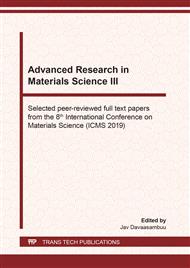[1]
J.E. Lilienfeld, Method and on apparatus for controlling electric currents, US patent 1,745,175A. (1926).
Google Scholar
[2]
R. Landauer, Irreversibility and Heat Generation in the Computing Process, IBM J. Res. Dev. 5(3) (1961) 183-191.
DOI: 10.1147/rd.53.0183
Google Scholar
[3]
N.A. Shelepin, Peculiarities of an elemental base of VLSI based on CMOS SOI with full depletion, Electronic Components 1 (2019) 31-33 (in Russian).
Google Scholar
[4]
E. Stern, J.F. Klemic, D.A. Routenberg, P.N. Wyrembak, D.B. Turner-Evans, A.D. Hamilton, D.A. LaVan, T.M. Fahmy, M.A. Reed, Label-free immunodetection with CMOS-compatible semiconducting nanowires, Nature 455 (2007) 519-522.
DOI: 10.1038/nature05498
Google Scholar
[5]
O.V. Naumova, B.I. Fomin, D.A. Nasimov, N.V. Dudchenko, S.F. Devyatova, E.D. Zhanaev, V.P. Popov, A.V. Latyshev, A.L. Aseev, Yu.D. Ivanov, A.I. Archakov, SOI nanowires as sensors for charge detection, Semicond. Sci. Tech. 25(6) (2010) 055004.
DOI: 10.1088/0268-1242/25/5/055004
Google Scholar
[6]
Yu.D. Ivanov, T.O. Pleshakova, A.F. Kozlov, K.A. Malsagova, N.V. Krokhin, A.L. Kaishev, I.D. Shumov, V.P. Popov, O.V. Naumova, B.I. Fomin, D.A. Nasimov, A.L. Aseev, A.I. Archakov, SOI-nanowire transistor for detection of D-NFATc1 molecules, Avtometriya 49(5) (2013) 119-126 (in Russian).
DOI: 10.3103/s8756699013050142
Google Scholar
[7]
V.P. Popov, M.A. Ilnitkii, E.D. Zhanaev, A.V. Myakon'kich, K.V. Rudenko, A.V. Glukhov, Biosensor properties of SOI nanowire transistors with a PEALD Al2O3 dielectric protective layer, Semiconductors 50(5) (2016) 632-638.
DOI: 10.1134/s1063782616050195
Google Scholar
[8]
A. Lichtenstein. E. Havivi, R. Shaham, E. Hahamy, R. Leibovich, A. Pevzner, V. Krivitsky, G. Davivi, R. Elnathan, Y. Engel, E. Flaxer, F. Patolsky, Supersensitive fingerprinting of explosives by chemically modified nanosensors arrays, Nature Commun. 5 (2014) 4195.
DOI: 10.1038/ncomms5195
Google Scholar
[9]
A.Cao, W.Zhu, J.Chang, J.H. Klootwijk, E.J.R. Sudholter, J.Huskens, L.C.P.M. de Smet, Metal–Organic Polyhedra-Coated Si Nanowires for the Sensitive Detection of Trace Explosives, Nano Lett. 17(1) (2017) 1-7.
DOI: 10.1021/acs.nanolett.6b02360
Google Scholar
[10]
V.A. Gritsenko, K.A. Nasyrov, Yu.N. Novikov, A.L. Aseev, S.Y. Yoon, J.-W. Lee, H.H. Lee, C.W. Kim, A new low voltage fast SONOS memory with high-k dielectric, Solid State Electron. 47(10) (2003) 1651-1656.
DOI: 10.1016/s0038-1101(03)00174-6
Google Scholar
[11]
V.A. Gritsenko, D.R. Islamov, Physics of dielectric films, first ed., Rzhanov Institute of Semiconductor Physics, Novosibirsk, 2017, 351 P. (in Russian).
Google Scholar
[12]
L. Chua, Memristor-The missing circuit element, IEEE T. Circuits Syst. 18(5) (1971) 507-519.
DOI: 10.1109/tct.1971.1083337
Google Scholar
[13]
D.B. Strukov, G.S. Snider, D.R. Stewart, R.S. Williams, The missing memristor found, Nature 453 (2008) 80-83.
DOI: 10.1038/nature06932
Google Scholar
[14]
K. Hayashi, S. Matsuishi, T. Kamiya, M. Hirano, H. Hosono, Light-induced conversion of an insulating refractory oxide into a persistent electronic conductor, Nature 419 (2002) 462-465.
DOI: 10.1038/nature01053
Google Scholar
[15]
А.М. Volodin, V.I. Zaikoskii, R.M. Kenzhin, A.F. Bedilo, I.V. Mishakov. A.V. Vedyagin, Synthesis of nanocrystalline calcium aluminate C12A7 under carbon nanoreactor conditions, Mater. Lett. 189 (2017) 210-212.
DOI: 10.1016/j.matlet.2016.11.112
Google Scholar
[16]
J.S. Oh, C.-J. Kang, Y.J. Kim, S. Sinn, M. Han, Y.J. Chang, B.-G. Park, S.W. Kim, H.-D. Kim, T.W. Noh, Evidence for Anionic Excess Electrons in a Quasi-Two-Dimensional Ca2N Electride by Angle-Resolved Photoemission Spectroscopy, J. Am. Chem. Soc. 138(8) (2011) 2496-2499.
DOI: 10.1021/jacs.5b12668
Google Scholar
[17]
Zh.I. Alferov, Nobel Lecture: The double heterostructure concept and its applications in physics, electronics, and technology, Phys-Usp. 172(9) (2002) 1068-1086 (in Russian).
Google Scholar
[18]
D.Yu. Protasov, D.V. Gulyaev, A.K. Bakarov, A.I. Toropov, K.S. Zhuravlev, The 2DEG mobility enhancement for low- and high-electric fields in a new type of AlGaAs/InGaAs heterostructures with donor-acceptor doping, J. Phys. Conf. Ser. 864 (2017) 012051.
DOI: 10.1088/1742-6596/864/1/012051
Google Scholar
[19]
V.A. Haisler, I.A. Derebesov, A.I. Toropov, I.I. Ryabzev, Emitters based on semiconductor Bragg microresonators, Avtometriya 47(5) (2011) 25-31 (in Russian).
Google Scholar
[20]
A.V. Gaisler, A.S. Yaroshevich, I.A. Derebezov, A.K. Kalagin, A.K. Bakarov, A.I. Toropov, D.V. Shcheglov, V.A. Gaisler, A.V. Latyshev, A.L. Aseev, Fine structure of the exciton states in InAs quantum dots, JETP Lett. 97(5) (2013) 274-278.
DOI: 10.1134/s0021364013050056
Google Scholar
[21]
M. Scholz, S. Buttner, O. Benson, A.I. Toropov, A.K. Bakarov, A.K. Kalagin, A. Lochmann, E. Stock, O. Scultz, F. Hopfer, V.A. Haisler, D. Bimberg, Non-classical light emission from a single electrically driven quantum dot, Opt. Express 15(15) (2007) 9107.
DOI: 10.1364/oe.15.009107
Google Scholar
[22]
A.V. Dvurechenskii, A.I. Yakimov, 1.4 - Silicon-Based Nanoheterostructures With Quantum Dots, in: A.V. Latyshev, A.V. Dvurechenskii, A.L. Aseev (Eds.), Advances in Semiconductor Nanostructures. Growth, Characterization, Properties and Application, Elsevier, Amsterdam, 2017. pp.59-99.
DOI: 10.1016/b978-0-12-810512-2.00004-4
Google Scholar
[23]
A.I. Yakimov, V.V. Kirienko, A.A. Bloshkin, V.A. Armbrister, A.V. Dvurechenskii, Plasmon polariton enhanced mid-infrared photodetectors based on Ge quantum dots in Si, J. Appl. Phys. 122(13) (2017) 133101.
DOI: 10.1063/1.4986986
Google Scholar
[24]
A.I. Yakimov, V.V. Kirienko, A.A. Bloshkin, V.A. Armbrister, A.V. Dvurechenskii, J.-M. Hartmann, Photovoltaic Ge/SiGe quantum dot mid-infrared photodetector enhanced by surface plasmons, Opt. Express 25(21) (2017) 25602-25611.
DOI: 10.1364/oe.25.025602
Google Scholar
[25]
A.F. Zinovieva, A.V. Dvurechenskii, V.V. Kirienko, A.I. Nikiforov, A.S. Lyubin, L.V. Kulik, Direct measurements of spin relaxation times of electrons in tunnel-coupled Ge/Si quantum dot arrays, Phys. Rev. B 81 (2010) 113303.
DOI: 10.1103/physrevb.81.113303
Google Scholar
[26]
Yu.G. Sidorov, A.P. Anciferov, V.S. Varavin, S.A. Dvoretsky, N.N. Mikhailov, M.V. Yakushev, I.V. Sabinins, V.G. Remesnik, D.G. Ikusov, I.N. Uzhakov, G.Yu. Sidorov, V.D. Kuzmin, S.V. Rihlicky, V.A. Shvets, A.S. Mardezhov, E.V. Spesivcev, A.K. Gutakovskii, A.V. Latyshev, 2.12 - Molecular Beam Epitaxy of CdxHg1−xTe, in: A.V. Latyshev, A.V. Dvurechenskii, A.L. Aseev (Eds.), Advances in Semiconductor Nanostructures. Growth, Characterization, Properties and Application, Elsevier, Amsterdam, 2017. pp.297-323.
DOI: 10.1016/b978-0-12-810512-2.00012-3
Google Scholar
[27]
E.B. Olshanetsky, S. Sassine, Z.D. Kvon, N.N. Mikhailov, S.A. Dvoretsky, J.C. Portal, A.L. Aseev, Quantum Hall liquid-insulator and plateau-to-plateau transitions in a high mobility 2D electron gas in an HgTe quantum well, JETP Lett. 84(10) (2006) 565-569.
DOI: 10.1134/s0021364006220085
Google Scholar
[28]
Z.D. Kvon, E.B. Olshanetsky, D.A. Kozlov, N.N. Mikhailov, S.A. Dvoretsky, 1.2 - Two-Dimensional Semimetal in HgTe-Based Quantum Wells, in: A.V. Latyshev, A.V. Dvurechenskii, A.L. Aseev (Eds.), Advances in Semiconductor Nanostructures. Growth, Characterization, Properties and Application, Elsevier, Amsterdam, 2017. pp.29-48.
DOI: 10.1016/b978-0-12-810512-2.00002-0
Google Scholar
[29]
G.M. Gusev, Z.D. Kvon, O.A. Shegai, N.N. Mikhailov, S.A. Dvoretsky, J.C. Portal, Transport in disordered two-dimensional topological insulators, Phys. Rev. B 84 (2011) 121302.
DOI: 10.1103/physrevb.84.121302
Google Scholar


